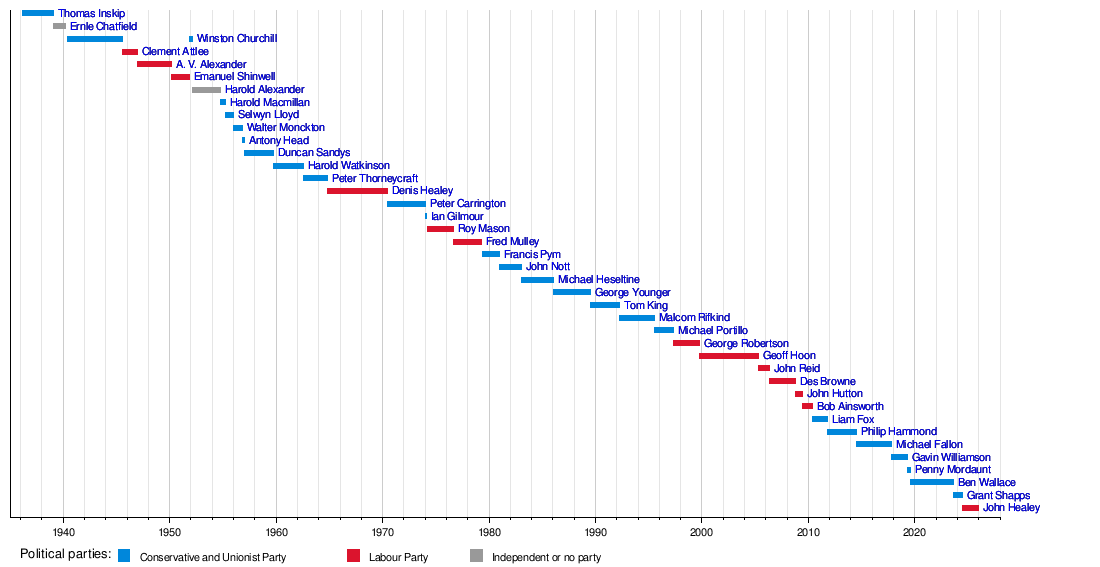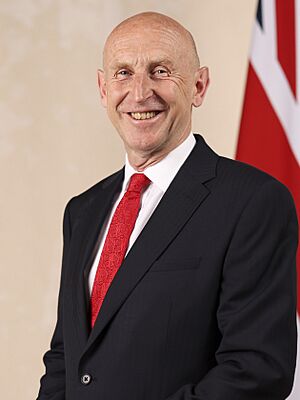Secretary of State for Defence facts for kids
Quick facts for kids United KingdomSecretary of State for Defence |
|
|---|---|

|
|
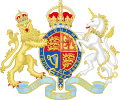
|
|
| Ministry of Defence | |
| Style |
|
| Member of |
|
| Reports to | The Prime Minister |
| Seat | Westminster |
| Nominator | The Prime Minister |
| Appointer | The Monarch
(on the advice of the Prime Minister)
|
| Term length | At His Majesty's pleasure |
| Constituting instrument | Defence (Transfer of Functions) Act 1964 section 1(1)(a) |
| Precursor |
|
| Formation | 1 April 1964 |
| First holder | Peter Thorneycroft |
| Salary | £159,038 per annum (2022) (including £86,584 MP salary) |
| Website | Defence Secretary |
The Secretary of State for Defence, often called the Defence Secretary, is a very important government official in the United Kingdom. This person is in charge of the Ministry of Defence. This ministry looks after the country's armed forces and its safety.
As a senior minister, the Defence Secretary is part of the Cabinet. The Cabinet is a group of the most important ministers who help the Prime Minister make big decisions for the country.
The job of Defence Secretary was created on 1 April 1964. It took over from several older roles, like the Minister of Defence and the heads of the Navy, Army, and Air Force. In 2019, Penny Mordaunt made history by becoming the first female Defence Secretary.
The Defence Secretary gets help from other ministers in the Defence Ministerial Team. They also work with the top civil servant in the ministry. The work of the Defence Secretary is checked by a special group called the Defence Select Committee.
Currently, the Defence Secretary is John Healey. He started this role on 5 July 2024, after the 2024 United Kingdom general election.
Contents
What the Defence Secretary Does
The Defence Secretary has many important jobs related to keeping the UK safe. Unlike defence ministers in some other countries, their role is very broad.
Key Responsibilities
- Planning Military Operations: They oversee big military plans and how the country defends itself.
- National Security: The Defence Secretary is a member of the National Security Council. This group makes sure the UK is safe from threats.
- Commanding the Armed Forces: They lead the Defence Council, which has the power from the King or Queen to command the British Armed Forces.
- Overseeing Intelligence: They keep an eye on Defence Intelligence, which gathers information to protect the country.
- International Partnerships: They manage relationships with other countries and groups, like NATO. NATO is a military alliance that helps keep its member countries safe.
- Defence Policy: They decide on important defence policies, including the Trident nuclear weapons programme. This program involves the UK's nuclear weapons.
- Managing Resources: They are responsible for how money and resources are used for defence.
- Communicating on Defence: They share information with the public about defence matters.
How the Role Developed
The job of Defence Secretary has changed a lot over time. It grew from earlier roles that focused on different parts of the military.
Minister for Co-ordination of Defence (1936–1940)
This job was created in 1936. Its main goal was to make sure Britain's armed forces were ready. This was important because of concerns about Nazi Germany. The Prime Minister, Stanley Baldwin, set up this role.
When Second World War started, this minister was supposed to speak for the Navy, Army, and Air Force leaders. However, these three leaders also joined the Cabinet. This made the Co-ordination Minister's job less important. The role ended in April 1940.
Minister of Defence (1940–1964)
The role of Minister of Defence was created in 1940. This person was in charge of coordinating all defence and security matters. Winston Churchill created this new job for himself when he became Prime Minister. He wanted one clear minister to lead the country's efforts in World War II.
After the war, in 1946, this role became the main Cabinet position for the military. The leaders of the Navy, Army, and Air Force then reported to the Minister of Defence. This setup continued until 1964.
Secretary of State for Defence (1964–Present)
The current role of Secretary of State for Defence began in 1964. It combined the responsibilities of the Minister of Defence and the separate heads of the Navy, Army, and Air Force. The old departments like the Admiralty and War Office were all merged into the new Ministry of Defence. This change created a single, powerful department to manage all of the UK's defence.
Secretaries of State for Defence (1964–Present)
The table below shows the people who have held the role of Secretary of State for Defence since it was created in 1964.
| Portrait | Name (birth–death) |
Term of office | Tenure | Party | Ministry | ||
|---|---|---|---|---|---|---|---|
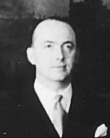 |
Peter Thorneycroft MP for Monmouth (1909–1994) |
1 April 1964 | 16 October 1964 | 198 days | Conservative | Douglas-Home | |
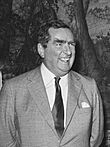 |
Denis Healey MP for Leeds East (1917–2015) |
16 October 1964 | 19 June 1970 | 5 years, 246 days | Labour | Wilson (I & II) |
|
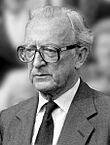 |
Peter Carrington 6th Baron Carrington (1919–2018) |
20 June 1970 | 8 January 1974 | 3 years, 202 days | Conservative | Heath | |
| Ian Gilmour MP for Central Norfolk (1926–2007) |
8 January 1974 | 4 March 1974 | 55 days | Conservative | |||
| Roy Mason MP for Barnsley (1924–2015) |
5 March 1974 | 9 September 1976 | 2 years, 188 days | Labour | Wilson (III & IV) |
||
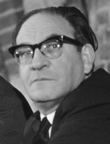 |
Fred Mulley MP for Sheffield Park (1918–1995) |
10 September 1976 | 4 May 1979 | 2 years, 236 days | Labour | Callaghan | |
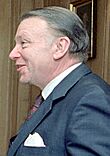 |
Francis Pym MP for Cambridgeshire (1922–2008) |
5 May 1979 | 4 January 1981 | 1 year, 244 days | Conservative | Thatcher I | |
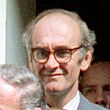 |
John Nott MP for St Ives (born 1932) |
5 January 1981 | 5 January 1983 | 2 years, 0 days | Conservative | ||
 |
Michael Heseltine MP for Henley (born 1933) |
6 January 1983 | 8 January 1986 | 3 years, 2 days | Conservative | Thatcher II | |
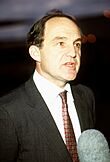 |
George Younger MP for Ayr (1931–2003) |
9 January 1986 | 23 July 1989 | 3 years, 195 days | Conservative | ||
| Thatcher III | |||||||
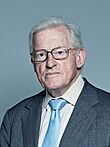 |
Tom King MP for Bridgwater (born 1933) |
28 July 1989 | 9 April 1992 | 2 years, 256 days | Conservative | ||
| Major I | |||||||
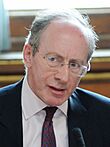 |
Malcolm Rifkind MP for Edinburgh Pentlands (born 1946) |
10 April 1992 | 4 July 1995 | 3 years, 85 days | Conservative | Major II | |
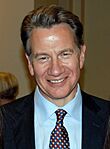 |
Michael Portillo MP for Enfield Southgate (born 1953) |
5 July 1995 | 2 May 1997 | 1 year, 301 days | Conservative | ||
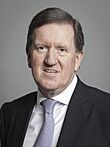 |
George Robertson MP for Hamilton South (born 1946) |
3 May 1997 | 11 October 1999 | 2 years, 161 days | Labour | Blair I | |
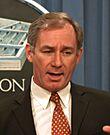 |
Geoff Hoon MP for Ashfield (born 1953) |
11 October 1999 | 6 May 2005 | 5 years, 207 days | Labour | ||
| Blair II | |||||||
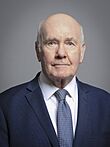 |
John Reid MP for Airdrie and Shotts (born 1947) |
6 May 2005 | 5 May 2006 | 364 days | Labour | Blair III | |
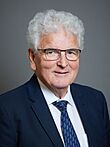 |
Des Browne MP for Kilmarnock and Loudoun (born 1952) |
5 May 2006 | 3 October 2008 | 2 years, 151 days | Labour | ||
| Brown | |||||||
 |
John Hutton MP for Barrow and Furness (born 1955) |
3 October 2008 | 5 June 2009 | 245 days | Labour | ||
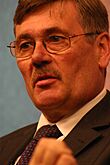 |
Bob Ainsworth MP for Coventry North East (born 1952) |
5 June 2009 | 11 May 2010 | 340 days | Labour | ||
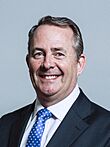 |
Liam Fox MP for North Somerset (born 1961) |
12 May 2010 | 14 October 2011 | 1 year, 156 days | Conservative | Cameron–Clegg (Con.–L.D.) |
|
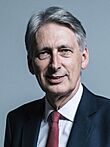 |
Philip Hammond MP for Runnymede and Weybridge (born 1955) |
14 October 2011 | 15 July 2014 | 2 years, 274 days | Conservative | ||
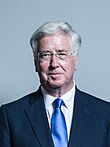 |
Michael Fallon MP for Sevenoaks (born 1952) |
15 July 2014 | 1 November 2017 | 3 years, 109 days | Conservative | ||
| Cameron II | |||||||
| May I | |||||||
| May II | |||||||
 |
Gavin Williamson MP for South Staffordshire (born 1976) |
2 November 2017 | 1 May 2019 | 1 year, 180 days | Conservative | ||
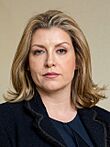 |
Penny Mordaunt MP for Portsmouth North (born 1973) |
1 May 2019 | 24 July 2019 | 84 days | Conservative | ||
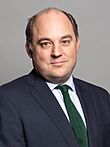 |
Ben Wallace MP for Wyre and Preston North (born 1970) |
24 July 2019 | 31 August 2023 | 4 years, 38 days | Conservative | Johnson I | |
| Johnson II | |||||||
| Truss | |||||||
| Sunak | |||||||
 |
Grant Shapps MP for Welwyn Hatfield (born 1968) |
31 August 2023 | 5 July 2024 | 2 years, 128 days | Conservative | ||
 |
John Healey MP for Wentworth and Dearne (born 1960) |
5 July 2024 | Incumbent | 1 year, 185 days | Labour | Starmer | |
Timeline of Defence Leaders
This timeline shows the different people who have held the top defence roles in the UK since 1936.
